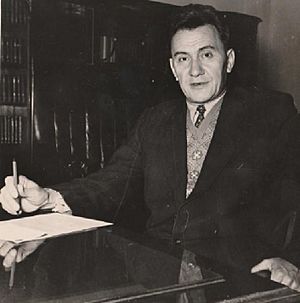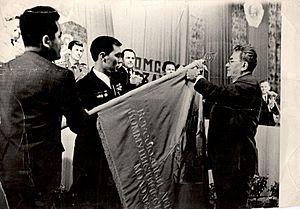Dinmukhamed Kunaev facts for kids
Quick facts for kids
Dinmukhamed Kunaev
|
|
|---|---|
| Дінмұхаммед Қонаев | |

Kunayev in 1952
|
|
| First Secretary of the Communist Party of Kazakhstan | |
| In office 7 December 1964 – 16 December 1986 |
|
| Preceded by | Ismail Yusupov |
| Succeeded by | Gennady Kolbin |
| In office 19 January 1960 – 26 December 1962 |
|
| Preceded by | Nikolay Belyayev |
| Succeeded by | Ismail Yusupov |
| Chairman of the Council of Ministers of the Kazakh SSR | |
| In office 26 December 1962 – 7 December 1964 |
|
| Preceded by | Masymkhan Beysembayev |
| Succeeded by | Masymkhan Beysembayev |
| In office 31 March 1955 – 29 January 1960 |
|
| Preceded by | Elubay Taibekov |
| Succeeded by | Zhumabek Tashenev |
| Full member of the 24th, 25th, 26th, 27th Politburo | |
| In office 9 April 1971 – 28 January 1987 |
|
| Candidate member of the 23rd Politburo | |
| In office 8 April 1966 – 9 April 1971 |
|
| Personal details | |
| Born | 12 January 1912 Verny, Semirechye Oblast, Russian Empire (now Almaty, Kazakhstan) |
| Died | 22 August 1993 (aged 81) Almaty, Kazakhstan |
| Political party | Communist Party of the Soviet Union (1939–1989) |
Dinmukhamed Akhmetuly "Dimash" Kunaev (1912–1993) was an important Kazakh politician during the time of the Soviet Union. He was the leader, or First Secretary, of the Communist Party of Kazakhstan for many years. He played a big role in developing Kazakhstan's economy and improving life for its people.
Contents
Early Life and Education
Dinmukhamed Kunaev was born on January 12, 1912, in Verny, which is now Almaty, Kazakhstan. His father, Minliakhmed, worked in farming and trade. His mother, Zaure, came from a family that was not wealthy. They lived together for 70 years.
Kunaev finished secondary school in Almaty in 1930. He then went to study in Moscow and graduated in 1936. He became a machine operator, which is someone who works with machines. By 1939, he was a chief engineer at a mine. Around this time, he also joined the Communist Party of the Soviet Union, which was a requirement for his job.
Rise to Power in Kazakhstan
Kunaev quickly rose through the ranks in the government of the Kazakh SSR (Kazakh Soviet Socialist Republic).
Early Government Roles
From 1942 to 1946, he was the deputy chairman of the Council of People's Commissars of the Kazakh SSR. During World War II, he helped move factories to Kazakhstan and trained people for the army. From 1946 to 1952, he was deputy chairman of the Council of Ministers of the Kazakh SSR.
In 1952, Kunaev became the President of the Kazakhstan Academy of Sciences. Under his leadership, the Academy worked on improving industry and farming in Kazakhstan. He held this position until 1955.
Becoming a Leader
Kunaev's career was closely connected to Leonid Brezhnev, who later became the leader of the Soviet Union. They became close friends. In 1955, Kunaev became the Chairman of the Council of Ministers of the Kazakh SSR.
On January 19, 1960, Dinmukhamed Kunaev was chosen as the First Secretary of the Communist Party of Kazakhstan. This made him the top leader in the republic.
Leading Kazakhstan
As First Secretary, Kunaev supported the Virgin Lands campaign. This project turned millions of hectares of land in central Kazakhstan into farmland. It also brought many Russian people to live in Kazakhstan.
Challenges and Return to Power
In 1962, Kunaev was removed from his position because he disagreed with the Soviet leader Nikita Khrushchev about moving some land from Southern Kazakhstan to Uzbekistan. Ismail Yusupov took his place.
However, Kunaev returned as Chairman of the Council of Ministers until 1964. When Khrushchev was removed from power and replaced by Brezhnev, Kunaev became the First Secretary of the Communist Party of Kazakhstan again in 1964. He stayed in this powerful role for 22 more years. From 1971 to 1987, he was also a full member of the Politburo, which was the main decision-making body of the Soviet Union.

Later Years and Dismissal
During Kunaev's long time as leader, many Kazakh people got important jobs in government, businesses, and schools. In 1984, he made Nursultan Nazarbayev the Chairman of the Council of Ministers.
However, things changed in 1986. Nazarbayev criticized Kunaev's brother, who was leading the Academy of Sciences. This made Kunaev very angry. He went to Moscow to try and get Nazarbayev fired. But instead, Kunaev himself was removed from his job by Mikhail Gorbachev, the new Soviet leader. Gorbachev accused him of corruption.
On December 16, 1986, Gennady Kolbin replaced Kunaev. Kolbin had never lived in Kazakhstan before. This decision caused three days of protests and riots in Almaty, from December 16 to 18, 1986. These events are now known as Jeltoqsan (meaning December in Kazakh).
In 1987, Kunaev was removed from the Politburo and other high-level positions. After this, he lived in his hometown of Almaty. He passed away on August 22, 1993, at the age of 81. He was buried in Almaty.
Key Positions Held
Dinmukhamed Kunaev held many important leadership roles during his career:
- Deputy chairman of the Council of People's Commissars of the Kazakh SSR (1942–46)
- President of the Academy of Sciences of the Kazakh SSR (1952–55)
- Chairman of the Council of Ministers of the Kazakh SSR (1955–60, 1962–64)
- 1st Secretary of the Communist Party of Kazakhstan (1960–62, 1964–86)
- Member of the Central Committee of the CPSU (1956–87)
- Full Member of the Politburo of the Central Committee of the CPSU (1971–87)
Achievements and Legacy
Under Dinmukhamed Kunaev's leadership, Kazakhstan saw a lot of economic growth. The country's industries, especially mining and energy, grew significantly. Farming also improved, with Kazakhstan producing large amounts of grain.
Kunaev himself wrote about his efforts to improve living standards and the economy in his book "From Stalin to Gorbachev." By the end of his time in power, Kazakhstan's economy had grown seven times compared to 1955. It became the third largest economy in the Soviet Union.
Because of these achievements, many Kazakh people still call the Kunaev era the "Golden Age of Kazakhstan."
Honors and Memorials
Kunaev is remembered in many ways:
- A monument and a bust (a sculpture of his head and shoulders) are in Almaty and other cities like Taraz.
- Many streets in Kazakhstan are named after him, including a main street in Almaty.
- The Eurasian Law Academy in Almaty is named after Kunaev.
- The Kunaev Home Museum in Almaty, opened in 2002, shows his life and work.
- The city of Kapchagay was renamed Qonayev in his honor in 2022.
- In 2022, a monument was opened in Bakanas, and a mural (a large painting on a wall) of him appeared in Almaty.
Awards
Dinmukhamed Kunaev received many awards for his service.
Soviet Awards
| Thrice Hero of Socialist Labour (1972, 1976, 1982) | |
| 8 times Order of Lenin (1957, 1962, 1971, 1972, 1973, 1976, 1979, 1982) | |
| Order of the October Revolution (1967) | |
| Order of the Patriotic War of the 1st degree (1985) | |
| Order of the Red Banner of Labour (1945) | |
| Medal "For Labour Valour" (1959) | |
| Medal "For Distinguished Labour" (1939) | |
| Medal "For Valiant Labour in the Great Patriotic War 1941–1945" (1945) | |
| Medal "For the Development of Virgin Lands" (1956) |
Foreign Awards
| Order of Georgi Dimitrov (1982, Bulgaria) | |
| Order of Sukhbaatar (1974, Mongolia) |
Images for kids
See also
 In Spanish: Dinmujamed Kunáyev para niños
In Spanish: Dinmujamed Kunáyev para niños




